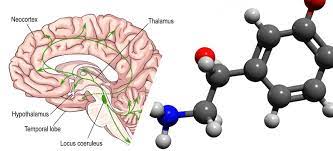
Norepinephrine, often referred to as the “fight or flight” hormone, is a crucial neurotransmitter and hormone that plays a central role in the human body’s response to stress. It belongs to a class of chemicals known as catecholamines and is produced by both the adrenal glands and certain neurons in the brain. In this article, we will delve into the multifaceted functions of norepinephrine, its physiological effects, and the diverse ways it influences our mental and physical well-being.
The Basics of Norepinephrine
Norepinephrine, also known as noradrenaline, is a chemical messenger that belongs to the family of monoamine neurotransmitters. It is synthesized from dopamine through a series of enzymatic reactions. Once produced, norepinephrine is released into the bloodstream as a hormone and also acts as a neurotransmitter within the central nervous system.
The production and release of norepinephrine are tightly regulated by various factors, including stress, physical activity, and certain medical conditions. When the body perceives a threat or stressor, the sympathetic nervous system is activated, leading to the release of norepinephrine. This activation prepares the body for the “fight or flight” response, a critical mechanism for survival in the face of danger.
Physiological Effects
- Cardiovascular System: Norepinephrine exerts a profound impact on the cardiovascular system. It increases heart rate and the force of cardiac contractions, leading to an elevation in blood pressure. This response ensures that the body is adequately supplied with oxygen and nutrients during times of stress or physical exertion.
- Respiratory System: In addition to its cardiovascular effects, norepinephrine also stimulates the respiratory system. It dilates the airways, allowing for increased oxygen intake. This is essential for providing the body with the oxygen necessary for heightened physical activity during the fight or flight response.
- Metabolism: Norepinephrine influences metabolic processes by promoting the breakdown of glycogen into glucose. This ensures a readily available source of energy to fuel the body’s increased demands during stress. Moreover, it facilitates the mobilization of fat stores, contributing to the energy needed for sustained physical activity.
Neurotransmitter Functions
Beyond its role as a hormone, norepinephrine functions as a neurotransmitter in the central nervous system. It plays a key role in modulating mood, attention, and arousal. Neurons that release norepinephrine are concentrated in certain brain regions, including the locus coeruleus. Here are some of the neurotransmitter functions of norepinephrine:
- Mood Regulation: Norepinephrine is implicated in the regulation of mood, and imbalances in its levels have been associated with mood disorders such as depression and anxiety. Medications that target norepinephrine reuptake, such as certain antidepressants, aim to modulate its levels in the brain to alleviate symptoms of these disorders.
- Attention and Alertness: Norepinephrine is crucial for maintaining attention and promoting alertness. It enhances cognitive functions, including focus and concentration. Dysfunction in the norepinephrine system has been linked to attention deficit hyperactivity disorder (ADHD), and stimulant medications used to treat ADHD often act by increasing norepinephrine levels in the brain.
- Memory Formation: Norepinephrine has been shown to play a role in memory formation. It facilitates the consolidation of memories, particularly those associated with emotionally salient events. This highlights its involvement in the encoding and retrieval of information in the brain.
Clinical Implications
- Psychiatric Disorders: Dysregulation of norepinephrine levels has been implicated in various psychiatric disorders. For instance, an overactive sympathetic nervous system leading to excessive norepinephrine release is observed in conditions like post-traumatic stress disorder (PTSD). Understanding these mechanisms is crucial for developing targeted pharmacological interventions.
- Cardiovascular Diseases: Imbalances in norepinephrine signaling are associated with cardiovascular diseases. Chronic elevation of norepinephrine levels can contribute to hypertension and heart failure. Medications that modulate norepinephrine receptors are commonly used to manage these conditions.
Conclusion
norepinephrine is a versatile neurotransmitter and hormone with far-reaching effects on the human body. Its intricate involvement in the “fight or flight” response, cardiovascular regulation, and central nervous system functioning underscores its significance in maintaining homeostasis. As researchers continue to unravel the complexities of norepinephrine’s role in health and disease, it opens avenues for developing targeted therapeutic interventions that harness its potential for improving both physical and mental well-being.